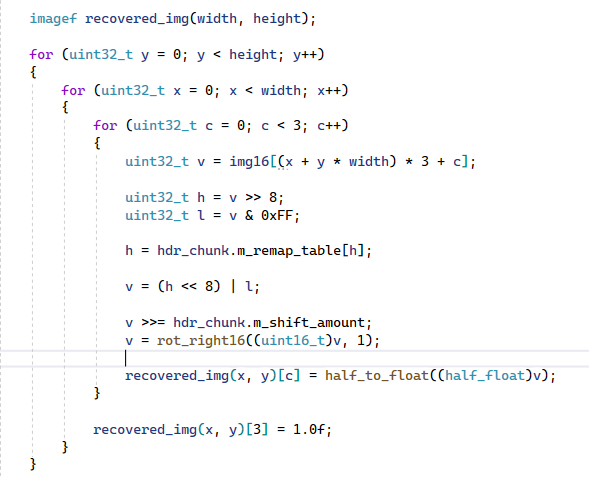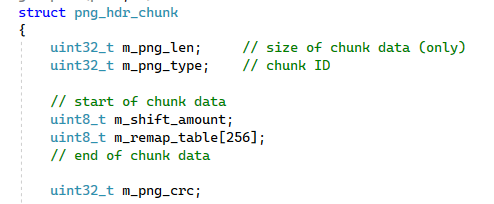- From: Richard Geldreich <rich@binomial.info>
- Date: Fri, 10 Nov 2023 23:04:40 -0500
- To: public-png@w3.org
- Message-ID: <CAMJqMUTosaQWAmfvpsv0Ky2pXWfPqnQ_G3cFrCVTmRtAfUuyvg@mail.gmail.com>
Here's how the half float pixel values are losslessly recovered from 16-bit/component HDR PNG images in the "hdrpng" example code. This is the entire decoding procedure. This code extracts the low and high bytes from the stored PNG's 16-bpp pixels, remaps the high byte through the lookup table read from the "hdRa" ancillary chunk (below), shifts right the 16-bit value from [0,15] bits (this is typically 0, but for darker images it may be a small # of bits), and then rotates the sign bit back into the MSB from the LSB of the 16-bit value. This standard half float value can then be processed in an HDR pipeline. The lossless encoder that takes half-floats and outputs 16-bit PNG values is more complex, but not by much. It has to determine the shift amount by examining all the half floats in the image and a high byte histogram, and then compute a 256 entry lookup table using some sort of tone mapping algorithm. The table must be computed in a way that results in no loss. [image: image.png] [image: image.png] On Fri, Nov 10, 2023 at 4:48 AM Richard Geldreich <rich@binomial.info> wrote: > If you want to see these example HDR .PNG's, unpacked to HDR .EXR files, > using an in-browser HDR viewer, I've unpacked them (using the example > hdrpng tool) to github here: > https://github.com/richgel999/png16/tree/main/bin/unpacked > > The EXR viewer app (it's pretty good - I use it for testing on SDR > monitors): > https://viewer.openhdr.org/ > > > On Fri, Nov 10, 2023 at 4:34 AM Richard Geldreich <rich@binomial.info> > wrote: > >> I've found a lossless and trivally invertible transform that takes >> half-float HDR values (typically read from .HDR or .EXR images) and packs >> them to 16-bit unsigned pixels that are completely compatible with existing >> non-HDR aware PNG software. It uses a simple invertible and lossless global >> tone mapping operator that operates directly on the half-float values. Old >> readers view and see these PNG's as 16-bit PNG's (so usually 48bpp per >> pixel for RGB). >> >> The high bytes are tone mapped so the 16bpp images appear passable to >> existing readers. New readers can parse a small ~257 byte ancillary chunk >> which contains a byte remapping table used to remap the high bytes of the >> 16-bit components in the PNG image back to half-floats. (It's a little bit >> more complex than this to deal with signed floats and very low values, but >> that's the gist of it.) It's lossless for all valid half-float values >> (normals, denormals, signed). I filter out any NaN's/Inf"s in this test. >> >> You can see a bunch of example 48-bpp PNG's packed from .EXR images in >> this way here: >> https://github.com/richgel999/png16/tree/main/bin >> >> The C++ source to the example "hdrpng" tool is here. The example app >> excluding image reading/writing is only ~450 lines of code. (It currently >> compiles with VS 2022 under Windows - I'll add a Linux cmake file next.) >> https://github.com/richgel999/png16/ >> >> It uses the popular open source lodepng library, unmodified, to write and >> read 16-bit PNG files and manipulate the ancillary "hdRa" chunk. >> hdrpng supports packing and tone mapping .EXR images to .PNG, unpacking HDR >> .PNG to .EXR, and an .EXR file comparison mode to verify that the half >> float values can be 100% recovered from the PNG file with no loss. The tone >> mapping in this example is automatic. >> >> I've tested the resulting 48bpp PNG files with pngcheck, Windows >> Explorer, Chrome, Paint Shop Pro, several tools, and the Windows Photo >> viewer app. So far, so good - they all look fine. >> >> Here are a couple example 48bpp PNG files. (Not sure what gmail will do >> to them, but this is what they look like.) These are how existing PNG >> readers view these HDR files. The half-float data is 100% preserved in >> these .PNG files, so HDR capable viewers are able to retrieve the original >> half-float pixels and do their own tone mapping or HDR processing. >> >> [image: Kapaa.png] >> [image: memorial.png] >> >> These PNG's validate successfully using pngcheck, because they are >> completely standard PNG files that any reader can load: >> >> [image: image.png] >> >
Attachments
- image/png attachment: Kapaa.png

- image/png attachment: memorial.png

- image/png attachment: image.png

- image/png attachment: 04-image.png

- image/png attachment: 05-image.png

Received on Saturday, 11 November 2023 04:05:01 UTC